Enslaved Persons in the Civil War
Enslaved Persons in the Civil War
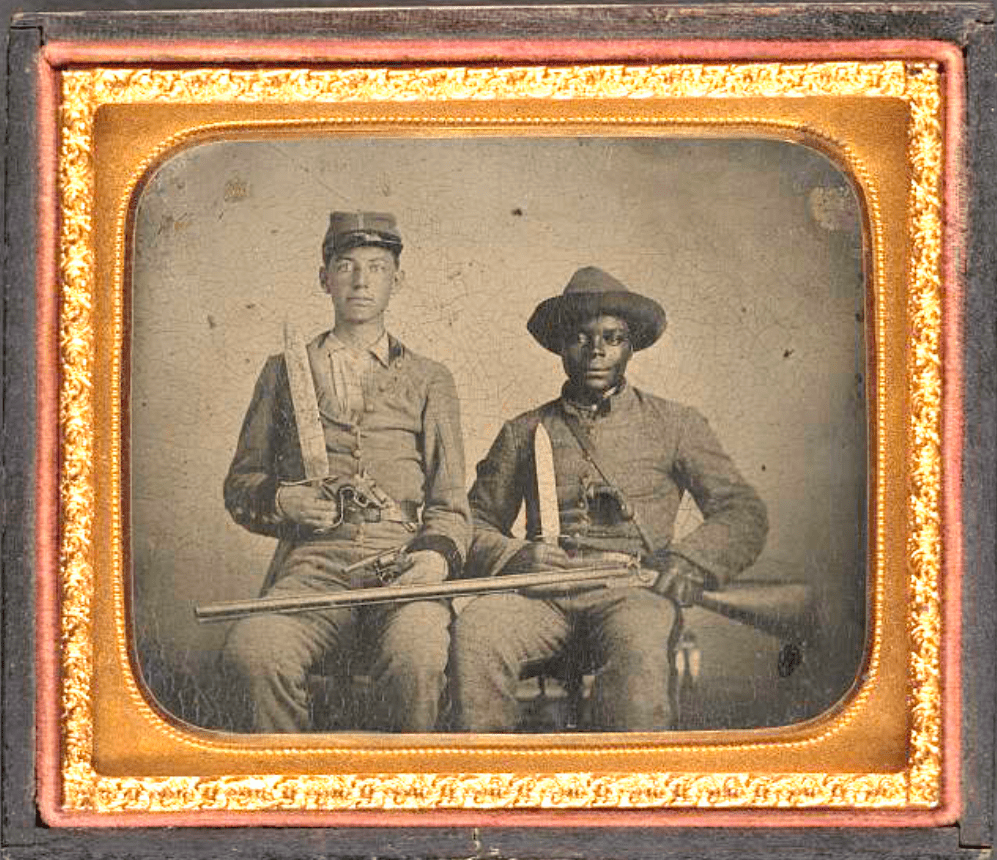
[1] During the years 1861 to 1865, African Americans responded to the American Civil War in a variety of ways. From a descriptive narration in Encyclopedia Virginia, we can get an idea of the broad spectrum of how the enslaved reacted or how their labor was used during this time:
Some volunteered to assist the Confederate war effort, while many others were forced to support the Confederacy, working on farms and in factories and households throughout Virginia. Thousands escaped to the Union army’s lines, earning their freedom and forcing the United States to develop a uniform policy regarding emancipation. Others remained on their home plantations and farms but took advantage of the war to gain some measure of autonomy…
[The] wartime increase in slave hiring brought numerous disruptions to slaves’ family lives. Enslaved men impressed to work on fortifications or hired to Confederate officers and industrial employers usually left their wives and children behind, placing a heavier work burden on enslaved women.
In addition to the slaves hired to work for private industries or various military departments, thousands of slaves endured harsh working and living conditions while impressed to build fortifications under the Confederate Engineer Bureau.[2]
In the book Slaves in the Family,[3] an example of how some of the enslaved were treated during the Civil War explains that they were brought to the war along with the enlisted men who were their enslavers:
Swept up by their enthusiasm, young Ball sons enlisted as they came of age; but loath to give up their comforts, they brought personal servants with them to the battlefield.
Some of the men who actually fought in the war faced familiar racial discrimination as explained in an article from Social Education:[4]
Black soldiers were initially paid $10 per month from which $3 was automatically deducted for clothing, resulting in a net pay of $7. In contrast, white soldiers received $13 per month from which no clothing allowance was drawn. In June 1864 Congress granted equal pay to the U.S. Colored Troops and made the action retroactive. Black soldiers received the same rations and supplies. In addition, they received comparable medical care.
From this same source is a summary of African American participation and mortality compiled after the Civil War was over:[5]
By the end of the Civil War, roughly 179,000 black men (10% of the Union Army) served as soldiers in the U.S. Army and another 19,000 served in the Navy. Nearly 40,000 black soldiers died over the course of the war—30,000 of infection or disease. Black soldiers served in artillery and infantry and performed all noncombat support functions that sustain an army, as well. Black carpenters, chaplains, cooks, guards, laborers, nurses, scouts, spies, steamboat pilots, surgeons, and teamsters also contributed to the war cause. There were nearly 80 black commissioned officers. Black women, who could not formally join the Army, nonetheless served as nurses, spies, and scouts, the most famous being Harriet Tubman[6] who scouted for the 2d South Carolina Volunteers.
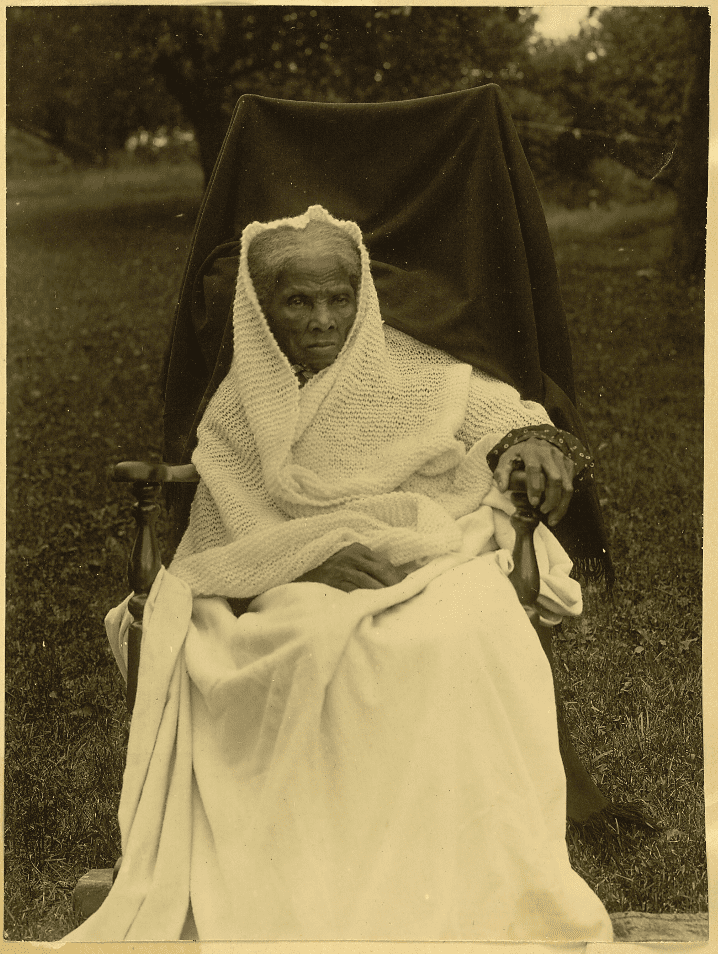
Records Naming Black Civil War Participants
If so many African Americans served in the Civil War, how can we find records naming them? There is a very expansive group of documents that list those who were paid for their work in the Confederate Engineer Bureau housed in the National Archives. These records have been digitized, although they are not yet indexed, which is an on-going project. Here is a link to those records: https://catalog.archives.gov/search?q=719477
The following is an example of what some of the records look like, but first an explanation. Some of these records name the individuals who were awarded the pay by the Engineer Corps, and some do not; they simply stated a description of what they did and the dates they worked:[7]
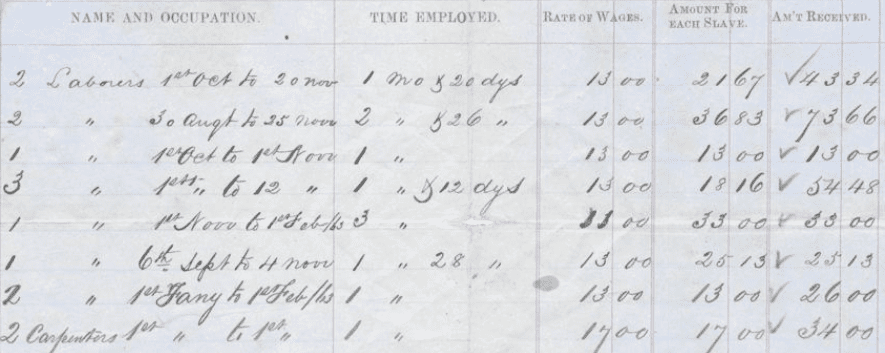
A question arises whether their enslavers actually rewarded the wages to the workers; likely not.
The next example, from Fort Pemberton in Mississippi, 1863, shows how you can discover the name of the enslaver of your person, if you know their name, and a general time and place when and where they lived, because the name of the enslaver is included in the record:[8]
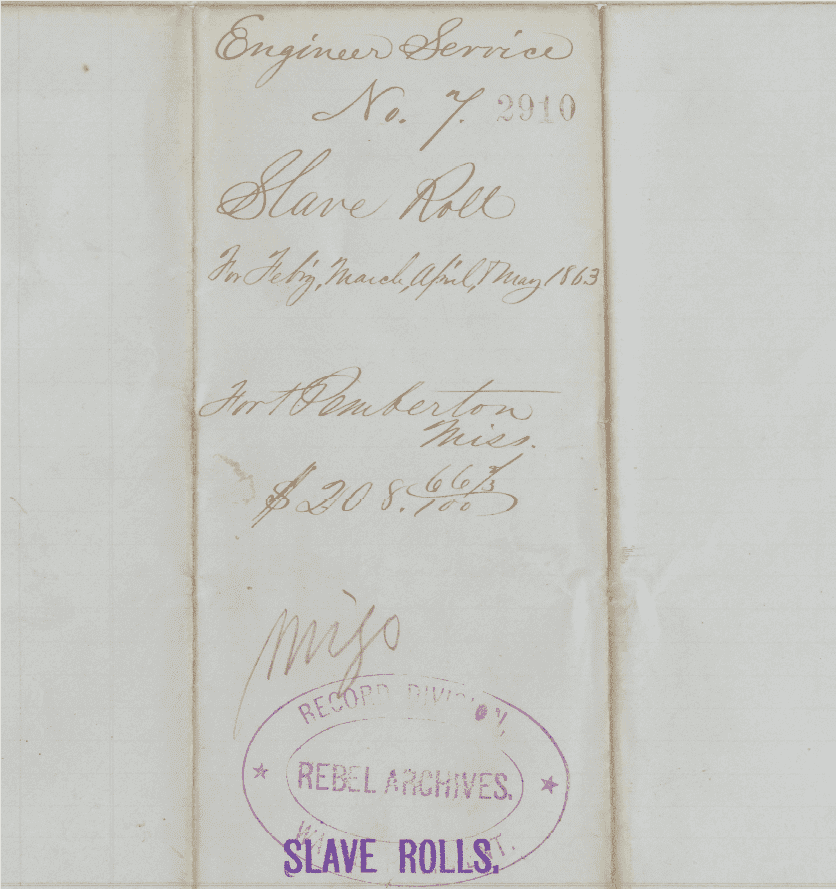
A digital copy of one side of the document shows the date and place where the enslaved men were hired to work for the war effort.
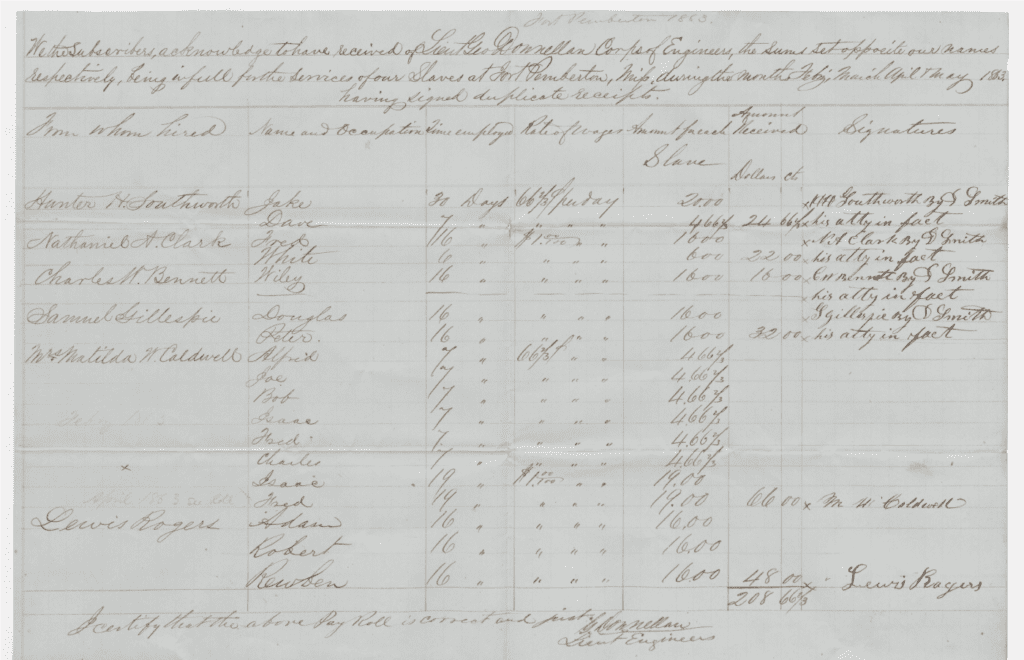
A specific example from this document, that of Mrs. Matilda Caldwell, shows Alfred, Joe, Bob, Isaac, Fred, and Charles worked for seven days, earning 66 2/3 cents per day, totaling to 4.66 2/3 dollars total for the time spent working at Fort Pemberton in Mississippi during the months of February, March, April and May in 1863. Isaac and Fred did an additional 19 days, earning $1.00 a day. It was interesting to determine what work they did, in this specific place, for such a short amount of time. A history of Fort Pemberton[9] reveals the fighters from the North tried to advance on Vicksburg by breaching “a levee on the Mississippi River about 300 miles north of Vicksburg, flooding a channel that previously connected the Mississippi River to the Tallahatchie River via Moon Lake and the Coldwater River. The channel, including its connected waterways, was known as the Yazoo Pass.” The Confederates became aware of this threat, and took measures, as described here:[10]
[General William W.] Loring arrived at Greenwood, Mississippi, on February 21, 1863. He quickly began constructing defenses at the junction of the Tallahatchie and Yazoo Rivers, about four miles downriver from Greenwood. By March 11, Loring’s men had created a series of artillery batteries, protected by earthworks and cotton bales. Rifle pits and entrenchment lines connected the batteries.
General Loring’s men included the enslaved persons named in the above document copied from the National Archives section found in Record Group 109: War Department Collection of Confederate Records in the series titled Confederate Quartermaster and Corps of Engineer Payrolls for Enslaved Labor. The biggest drawback to these records is they are not yet indexed, but with a lot of searching, they could hold a key to personal histories of African American individuals.
By Beth B.
[1] Photo from Public domain, via Wikimedia Commons https://upload.wikimedia.org/wikipedia/commons/6/68/Sergeant_A.M._Chandler_of_the_44th_Mississippi_Infantry_Regiment%2C_Co._F.%2C_and_Silas_Chandler%2C_family_slave%2C_with_Bowie_knives%2C_revolvers%2C_pepper-box%2C_shotgun%2C_and_canteen.jpg
[2] https://encyclopediavirginia.org/entries/slavery-during-the-civil-war/
[3] Ball, Edward, Slaves in the Family, page 322.
[4] Freeman, Elsie, Wynell Burroughs Schamel, and Jean West. “The Fight for Equal Rights: A Recruiting Poster for Black Soldiers in the Civil War.” Social Education 56, 2 (February 1992): 118-120. [Revised and updated in 1999 by Budge Weidman.]
[5] Freeman, Elsie, Wynell Burroughs Schamel, and Jean West. “The Fight for Equal Rights: A Recruiting Poster for Black Soldiers in the Civil War.” Social Education 56, 2 (February 1992): 118-120. [Revised and updated in 1999 by Budge Weidman.]
[6] Photograph of Harriet Tubman. Photograph. Retrieved from the Library of Congress, <www.loc.gov/item/rbcmiller002657/>.
[7] NAID: 90312432, Slave payroll 2632. National Archives.
[8] NAID: 90314694, Slave payroll 2910, National Archives
[9] https://www.americanhistorycentral.com/entries/battle-of-fort-pemberton/
[10] https://www.americanhistorycentral.com/entries/battle-of-fort-pemberton/
